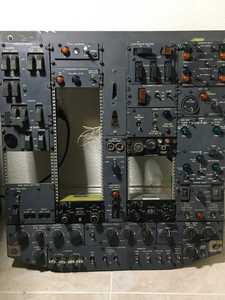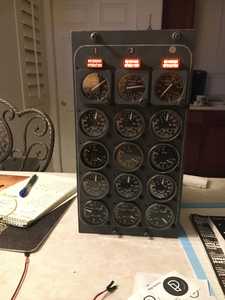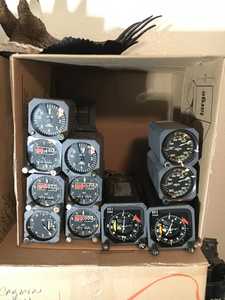Hello Bill,
hello everyone.
My name is Peter, I am german, 63 years old, doctorated in technical chemistry at RWTH-Aachen, and living since 1988 in Brazil. I have worked in development, production, quality control, and environmental technology for some multinational and national companies. I also worked in the MBA program of Getulio Vargas Foundation in Rio de Janeiro, a Brazilian higher education institution and think tank founded on December 20, 1944, with a mission "To stimulate Brazil’s socio-economic development".
Actually I work together with my Brazilian wife, a german language teacher, as sparring partner“ for conversation in german with our students. Many of them are studying chemical engineering at São Paulo University, which has a campus here in Lorena - SP.
My hobby is the construction/restoration of original Boeing 727-200 panels, such as MAIN PANEL, OVERHEAD PANEL, 2nd ENGINEERS PANEL, RADIOBOX and THROTTLE QUADRANT. I began my collection in 2007 and bought all original instruments and panels, in excellent quality and with fair prices, from Capt. Nick Louis, chairman of APHS, Airline Pilot´s Historical Society, in Illinois, USA. APHS is a non-profit, charitable foundation whose purpose is to educate through the preservation of aircraft parts and components. The money Nick and his sons raise goes either to educational projects, or to children's hospitals and organizations that specialize in the needs of children.
The physical mounting is nearly finished. Now, I want to work with the ARDUINOS to connect these panels and instruments to X-Plane 11 Flight simulator (as far, as I can).
Especially I want to drive SYNCHRO (Transmitters / Receivers) "SELSYNS" by ARDUINO. Normally , in aviation, these SYNCHROS are AC driven at 400 Hz with a 28 V Rotor and three 11.8 V coils (each 120°). For some instruments, the voltage can be up to 115 V.
There are two types of application of SYNCHROS that I need help and that I want to discuss on this forum:
- Moving SYNCHROS by ARDUINO, used as “motors” to drive the exact position of indicator needles or discs on aircraft instruments, such as on the RADIO MAGNETIC INDICATOR (RMI).
I want directly connect the 3 stator coils and the rotor coil to 4 H-Bridges per SYNCHRO and drive them by the ARDUINO, using the PWM-Mode.
- Measuring the exact position of SYNCHROS by ARDUINO, to determine mechanical inputs on a scale, such as done by the SET ALTITUDE INDICATOR.
I will create two SUBFORUMS in the ARDUINO Forum: SYNCHROS "SELSYNS" as Output Devices and SYNCHROS ”SELSYNS” as Input Devices.
I am a beginner with Arduino programming. Therefore I would need and appreciate the help of some specialists in the forum.
Peter!
A fellow Boeing 727-200 fan!
I, too, am building a home cockpit of the magnificent aircraft and hope we can become friends and share knowledge and best practices.
I look forward to hearing from you and learning about your project.
Jay
Las Vegas, NV
How fascinating! I used to fly Tiger Moth and Chipmonk and have a little flying wing model aeroplane and a Taranis radio controller. Sadly I have neglected this hobby but one day I hope to resume.
Hello Jay!
Thanks for your contact.
I am collecting B727 stuff since 2007 and completed my collection in 2019. Today it´s nearly impossible to find stuff to complete a full B727 project, because this old lady has almost gone.
Actually I reconstructed the Main Panel, integrating RT-Box and the Glare Shield. Doing so, I obtained the correct 5 to 7 degree inclination of the Main Panel.
I the meantime I have learned, that making it fully functional with a flight simulator, is out of my competence. Therefore I changed my project goals. Until november / december I will hook up the panel lights and instrument lights to arduinos and make the B727 panel as a stand alone unit, conserving it as historical artifact of aviation.
Bill´s DroneBot Workshop gives excellent instructions how to work with the arduinos. In order to be compilant with the DroneBot Forum rules, I cannot discuss construction details in this forum. But there are many flightsim forums and homecockpit builder sites on the internet.
I am still interested to work on the problem of interfacing some specific aircraft instruments, such as the RMI, to the arduino. Until now, I have no feasable solution.
I hope, that from december on, I will continue to work on this issue. As soon as I have new insights, I will post them in this forum.
Good luck and many happy landings!
Peter
In order to be compilant with the DroneBot Forum rules, I cannot discuss construction details in this forum
As I'm the one who created the rules, I'm puzzled as to which "rule" you would be breaking? On the contrary, I encourage anyone to give as many details about their projects as they feel comfortable sharing.
Peter, please feel free to share as much as you wish regarding this amazing project. I would suggest that you start a new thread, instead of keeping it in the "Introduce Yourself" section, as it will be easier to reference it later.
A great place to put this would be the "Show & Tell" section in the "Project Corner".
My father worked in the aerospace industry as an engineer, partly in the space program (Gemini, Apollo and Space Shuttle) and he also spent a decade designing aircraft simulators. He would have loved something like this!
So I definitely would encourage you to post as much about this as you wish!
😎
Bill
"Never trust a computer you can’t throw out a window." — Steve Wozniak
Many thanks Bill.
I apreciate the "liberty" you give to discuss different issues on your forum.
I admire your father. Working on the Apollo project ist a hightlight. As child, I followed each step of these missions.
Stay safe.
Peter
If you don't know about it already, think about a thumper(sometimes called a butt kicker, although that the more expensive name brand). Drummers use it to feel the lower frequencies that are not adequately reproduced by in ear monitors that we use now. Most music supply stores have it or will know about it(or online Big one, Small one). It attaches to your seat and vibrates it based off of the lower frequencies that you feed it through the audio line. This will give the the ability to feel the plane.
As to relevance or otherwise of your particular applications to Microcomputing:
I am at the stage where I know enough about coding to steal code - like a magpie and repurpose it to my needs.
As to matters Aeronautical and Space - too much of it is barely enough, in my estimation.
What is most poignant to me is the realization that Space is no fit place for a human being. As robots get better at doing the jobs out there, that need doing there is less and less justification for lofting bits of meat into the sky. Same applies to underground mining.
Love your space collection!
M
Peter..
I am so sorry for the very lengthy delay in replying…life does get in the way of our pastimes and personal projects at times and mine is no different.
I am in complete awe and admiration of your photo. That main instrument panel is EXACTLY what I’ve been looking for. I have 90-95% of the instruments/gauges and just need the panel frames, including the landing gear panel with either the 7 or 8 Korry switches. And yes, damn-near impossible to find these days. I do have the complete overhead here at home and have the complete flight engineer’s frames, panels and instrument/gauges being ‘held’ for me. Am also on the hunt for a glare shield. Also, I’m the very proud owner of a throttle quadrant obtained earlier this year. It’s currently sitting on my patio, all panels removed, thoroughly degreased and cleaned and a wood ‘floor’ frame attached so I can install string potentiometers for the thrust levers, flaps, trim wheels, etc. Quite the project!
Lately, I’ve been doing a ton of studying and reading on interfacing…especially the synchro-resolver operation. Some hobbyists say that PWM from Arduino is possible but admittedly, I’m a little gun shy in hooking-up theses precious instruments for fear I’ll permanently destroy them until I have a better and thorough grasp on operations. I also managed to find a script for Arduino for the synchro-resolvers as well as a program that reads data refs from X-Plane…but more study is on my agenda for these. I have a 115VAC/26VAC 400Hz converter as well as several 5-30VAC variable transformers so in my case, the correct power supplies aren’t an issue. I have the correct pin outs for many of these gauges with the exception of a Sperry HSI (Model MHR-4B), identical to the two (2) in your photo. For the engine gauges (N1, N2, Fuel Flow)…I’m in the process of gutting them and use automotive steppers (X27.168s) to drive the needles. I’ve got one converted thus far and am very happy with the results.
Please, keep in touch and if you hear of any 727-200 parts and pieces, let me know.
Stay safe and be well,
Jay
Hello Jay!
Thank you very much for your new contact.
Congratulations for your succes collecting all these B727 parts and instruments that you are listing. Today it is very difficult to get this stuff, because the „old lady“ has nearly gone.
I always recommend APHS – Airline Pilots Historical Society. Capt. (ret.) Nick Louis, and his sons. They always try to help a maximum.
The last months, I didn´t proceed with my project. Next year, I will try to continue.
Because of the complexity, hooking up the instruments, and having your concerns of destroying them, too, I am simplifying my project: At this stage, I will only conect the panel and instrument lightning to the Arduinos, without any needles.
Having done this, may be by the end of 2022, I will try to use some „dummy“ instruments conecting to the Arduinos. I dond´t have a 400 Hz converter, so I have to work directly with the Arduinos (and Darlington arrays).
The video clips that appear on the internet, working with 400 Hz inputs, you hear a horrible sound – very different to real aircraft. I dond´t know why this is so.
As you see, it´s a long term project.
I wish you many succes with your project. Keep me informed and updated. As well, I will do so.
Stay safe and keep well, too.
Peter
Hello, friend!
Very nice to hear from you. I am very familiar with Nick at APHS and have purchased several items from him. I could not agree more—very, very helpful and kind folks. I’ve also used EBay numerous times and was extremely lucky to have visited an aircraft boneyard in Mojave, CA a year-and-half ago where I picked-up many of my instruments and gauges as well as the complete overhead panel through a local Las Vegas contact here. My 2nd bedroom in the condo looks awfully like an airline parts and maintenance room!
As far as the 400Hz inverter goes….yes, that high-pitched whine can drive one to complete madness but it does lend to the overall experience. If/when I ever build or obtain the front end of a 727, the inverter will be located far from the cockpit; perhaps in the next county!
Don't give up entirely on the interfacing…yes, it’s a challenge and full of disappointments; I’m feeling VERY frustrated lately, solely due to my lack of practical knowledge of electronics and interfacing. Personally, I KNOW it all can be accomplished. The problem right now is the HOW and WHY! As an example…I’m trying to wire and code a trim wheel control test using Arduino Mega, an L298N H-bridge (to reverse polarity), a momentary rocker-type switch (similar to the actual trim wheel switch on the aircraft’s yoke…forward for nose down, back for nose up, center for off), a relay module and a 24VDC motor which will eventually be attached to the bottom of my TQ to drive the trim wheels attached to the motor via a bicycle-type chain, just like the real deal. I understand the principles but trying to successfully tie it all together is a different story. I’ve asked on the forum recently but haven’t learned anything from the replies. No worries…again, I know it can be done and it’s just going to take some more research and study to accomplish it. In the back of my mind, I try to always to make it fun…and NOT a chore that I hate doing. I’ve recently retired after a 45-year career and it sure beats sitting on my arse in front of the TV! I’m not yet willing to let my mind turn completely into mush.
I’ve attached photos of a few things in my current collection. Fun stuff here, huh?
One thing that I’ve learned: The instruments/gauges’ lighting work best via AC voltage. I learned that DC voltage amps are very different than AC voltage amps in that AC amperage is much lower than DC. I have the complete wiring guide for the B727 (4 very thick volumes) and couldn’t understand why the lighting connections always show AC. Thus the reason for using the 115VAC/26VAC 400Hz inverter with the variable 5-30VAC transformers. I’m using individual power busses for the sake of commonality and simplicity. You might want to look into this set-up as a power supply. I’m learning that preserving power is the name of the game in this hobby. As ever, I’m more than happy to help you when I can.
Keep in touch. I’m sure that between us, we’ll get these beautiful ladies functioning. Of this, I am certain.
Jay
Jay,
great stuff that you have there.
Interesting information about AC vs DC and the amps – but its logic.
To reduce energy consumption and heat emission, I have substituted the bulbs by LEDs (where ever possible). Of course, for the instrument ilumination, it was not possible.
Here some images of my collection.
Until next,
Peter
Funny you mention LEDs as substitutes for the internal lighting…I’ve ordered about 200 white LEDs and holders from LighthouseLEDs.com to do the very same thing!
Where did you get all your 727 stuff?
I am sooooooo jealous!! But nonetheless, very happy for you. It’s great seeing these old pieces of aircraft that are so very important to me.
Jay
eal727capt@gmail.com
I am collecting B727 stuff since 2007 and completed my collection in 2019. Each single part is from APHS – Nick Louis!
Nothing from e-bay.
Here in Brazil, it´s impossible.
Peter




